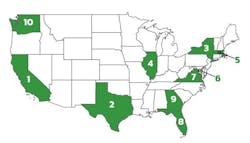Which State Has the Most LEED Buildings?
How green is your state?
Since the 1993 founding of the U.S. Green Building Council (USGBC), the number of sustainably constructed and managed buildings has grown exponentially – but not evenly. LEED certifications in places like California and Washington, D.C., have boomed while other states lag behind.
The Top 10 States
Surprisingly, the top 10 states vary significantly depending on the metric used to compare them. California dominates the rankings when the states are compared based on the amount of square footage that has successfully earned LEED certification already.
The Golden State has more than 768 million square feet of LEED-certified space, the biggest chunk of the nearly 4.4 billion certified square feet in the U.S.
States by Certified Square Footage
State Certified Buildings:
1. California 5,356
2. Texas 2,141
3. New York 1,997
4. Illinois 1,567
5. Massachusetts 1,111
6. District of Columbia 964
7. Virginia 1,370
8. Florida 1,640
9. Georgia 881
10. Washington 1,151
*United States Certified Buildings: 32,516 by sq. ft: 4,396,816,003
California ranks first again when the states are compared by total square feet. That number includes projects that are registered with USGBC but are still working toward official certification.
[Related: 10 Tips for Green Building Certification]
Some LEED systems, like LEED O+M for Existing Buildings, require project teams to meter building energy use for a full year to ensure efficient operation, which lengthens the application timeline.
States by Total LEED Square Feet (Certified and Registered)
Total Green Buildings:
1. California 11,040
2. Texas 4,689
3. New York 4,492
4. Illinois 2,852
5. Virginia 2,847
6. Florida 3,795
7. District of Columbia 2,110
8. Massachusetts 2,149
9. Maryland 2,564
10. Nevada 571
* United States Green Buildings: 67,085 by sq. ft: 10,234,437,850
However, ranking states by the number or square footage of certified buildings biases the rankings in favor of highly populated states with lots of large buildings contributing to the total and budgets that can support incentives for green buildings.
Looking at how many square feet of LEED-certified and registered space each state has per person reveals an entirely different top 10 – one that places Washington, D.C., at the top and barely includes California even though it tops both lists of total square footage.
Green Square Feet Per Capita
How to Add to the Certification Total
Certifying a building with a sustainability- or resilience-focused certification is a difficult yet rewarding experience that can contribute positively to your bottom line, as well as your ability to retain tenants. Set priorities by investigating your certification options and the requirements of each program. You can even set your sights extra high by targeting net zero energy consumption.
Determine whether your state or city offers any incentives that can help defray the cost of green certification. You may not be able to get help with the certification fees, but rebates and other financial assistance for things like energy-efficient equipment and lighting retrofits can help improve your energy performance to the level you’ll need to achieve certification.
Finally, bring together an enthusiastic green team of volunteers who will help you get buy-in from everyone else in the building. These key players usually include service providers and representatives from several departments or tenants and will help keep everyone else in the building in compliance with your newly sustainable operations and maintenance practices. Slow and steady is the name of the game when it comes to certification, so keep plugging away at the requirements – you’ll reach the finish line before you know it.
Two handpicked articles to read next:
About the Author
Janelle Penny
Editor-in-Chief at BUILDINGS
Janelle Penny has been with BUILDINGS since 2010. She is a two-time FOLIO: Eddie award winner who aims to deliver practical, actionable content for building owners and facilities professionals.

